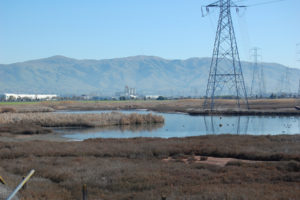In late May, eleven young poets and artists, ages 7 to 15, climbed aboard the Creek Seekers Express train at Jack London Square. These young people were the winners of a new award sponsored by the San Francisco Estuary Project for River of Words, which each year holds a free international poetry and art contest on the theme of watersheds. The daylong adventure took the students, family members, and guests on a train ride that hugged the San Pablo Bay shoreline while Christopher Richard, curator of aquatic biology at the Oakland Museum, narrated the journey. Martinez was the end of the line, where the kids learned about Alhambra Creek and its celebrity beavers, which have been at the center of a debate about creek management in a populated, flood-prone downtown.
Along the way the train passed over dozens of creeks: Rodeo, Refugio, and Rheem; Garrity, San Pablo, and Blackberry; Alhambra, Codornices, and Wildcat; Schoolhouse, Strawberry, and Temescal–names that read like poems. Though all the creeks flow into San Francisco Bay, they have been so altered, redirected, and constrained that most people barely know there are creeks such as these in their neighborhoods.
That is changing. Just as there was a “cultural revolution” that saved the Bay in the 1960s, creeks are well on their way to being recognized as a vibrant part of the fabric of urban communities. “Three women helped citizens see that it was socially, ecologically, and economically vital to have a healthy and celebrated San Francisco Bay,” Richard says. “We’re experiencing the same awakening of consciousness regarding our creeks.”
The Creek Seeker winners will recite their poems and display their art at the State of the Estuary conference, September 29 to October 1, 2009, in Oakland. For information on the conference, go to sfep.abag.ca.gov. Next year’s Creek Seekers award will go to participants who imagine landscape design changes that increase resilience to sea level rise. Find out more at www.riverofwords.org.
Perhaps those kids can find inspiration in another competition that sought to stimulate innovative design ideas to deal with sea level rise. Hosted by the San Francisco Bay Conservation and Development Commission (BCDC), “Rising Tides” attracted entries from around the world and was juried by architects, landscape architects, engineers, and life scientists. Sea level rise resulting from climate change will be one of the biggest challenges facing shoreline communities over the next century. A newly released BCDC map shows the effects of a projected 1.4-meter sea level rise on the Bay Area, with 213,000 acres vulnerable to flooding by 2100. Contest entries include narrative and visual models that address a shoreline or an entire watershed. The idea behind the competition, says BCDC design analyst Brad McCrea, was to “generate and share design responses to these challenges that can be applicable in San Francisco Bay and elsewhere around the world.”
See the $10,000 grand-prize winner along with all the entries on exhibit at the San Francisco Ferry Building from July 11 through July 19, 2009. Learn more at www.bcdc.ca.gov.

.jpg)



